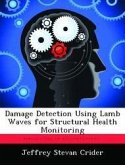A goal of structural health monitoring (SHM) is to increase aircraft readiness through condition based maintenance (i.e. servicing an aircraft only when it is known to be necessary). The lead ziconate titanate (PZT) is a commonly used piezoelectric transducer that has shown potential to detect damage in aircraft structures without time consuming manual inspections. But many locations identified by the USAF for SHM have restricted geometries, presenting difficulties using the PZT transducers successfully. One known fatigue location in an aircraft bulkhead has been selected as a basis to evaluate some of the challenges of using PZT transducers for SHM. The goal of this research is use analytical and experimental investigations to detect fatigue cracks in plates representing the restricted geometry of the aircraft bulkhead. This research shows that detecting closed fatigue cracks can be more challenging than detecting open cracks, but that opening the cracks using an applied static load presents new challenges.








